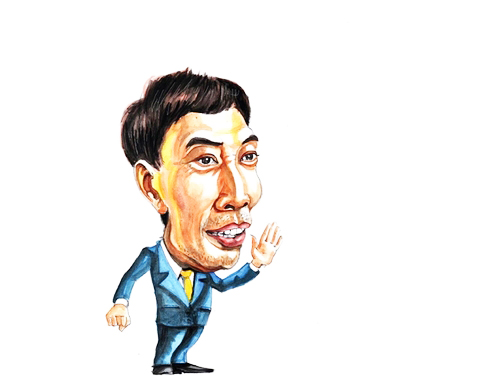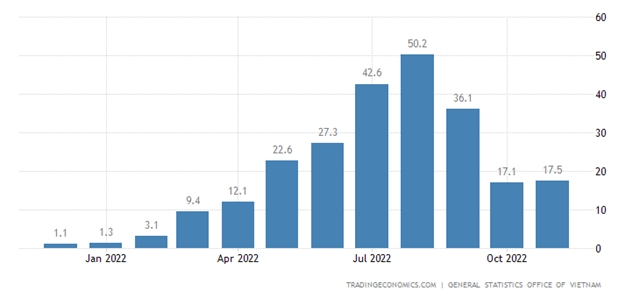 Economy
Economy

 |
| Võ Trí Thành |
*Võ Trí Thành
Consumption – one of the key drivers of Việt Nam's growth in 2022 – is showing signs of deceleration.
The General Statistics Office (GSO)'s data showed Việt Nam's total retail sales of goods and services in November increased 17.5 per cent year-on-year to an estimated VNĐ514.2 trillion (US$20.9 billion) after a 17.1 per cent growth a month earlier which was the slowest pace since April.
The latest figure marked the 12th straight month of expansion in the retail sector as consumption continued to rise despite ongoing cost pressure.
Ending November, the total retail sales of goods and services leapt 20.5 per cent year-on-year to VNĐ5.18 quadrillion ($219 billion) while it decreased 5 per cent in the same period of 2021; if excluding the price factor, the growth rate was just 16.9 per cent (down 6.8 per cent in the same period of 2021).
However, the 11-month figure this year represented a 14.9 per cent increase compared to 11 months of 2019 – the year before the COVID-19 pandemic broke out. According to GSO, the 11-month revenues only reached 82.5 per cent of the estimation under normal conditions from 2020 to the present.
A key driver in 2022
From the end of last year to the beginning of this year, many Government agencies and experts had predicted Việt Nam's growth in 2022 would depend on exports and the disbursement of public investment. Consumption at that time was not believed to have a strong growth to contribute significantly to the country's recovery with the rationale that after two years of undergoing the pandemic with several lockdowns and decreasing incomes, people would be cautious in spending and prone to save more to be well-prepared for unclear recovery path.
But in reality, Việt Nam's growth this year has relied heavily on consumption and export, partly to disburse foreign direct investment (FDI).
Exports, as expected, have played an important role in Việt Nam's strong recovery this year, with the total import and export turnover of goods in 11 months rising 11.8 per cent on-year to an estimated $673.8 billion, in which exports increased by 13.4 per and imports increased by 10.1 per cent. Trade surplus remained high at $10.6 billion in the last 11 months.
Disbursement of FDI in 11 months reached nearly $19.7 billion, up 15.1 per cent over the same period last year.
Meanwhile, the disbursement of State budget investment was slower than expected. Ending November, public investment disbursement reached only 58.3 per cent of the plan assigned by the Prime Minister, lower than the rate of 63.86 per cent recorded in the same period last year, according to the Ministry of Planning and Investment's 11-month report.
Retail trade has become a bright spot in this context, with an average growth of 21.8 per cent in the past 11 months. 'Revenge' consumption has driven up a boom in consumption in response to offset the hostile experience of being forced to 'stay-at-home' during the pandemic.
When the Government relaxed all the pandemic control, retail sales and travel picked up. Passenger transport increased in 11 months increased 48.7 per cent, while the number of international visitors to Việt Nam reached nearly three million, registering 21.1 times higher than last year (but still down 82 per cent compared to pre-pandemic levels).
In addition, recent statistics from the Vietnam National Administration of Tourism revealed that the number of domestic tourists in the first ten months reached nearly 92 million, up three times over the same period last year and surpassing 2019's number.
Current consumption is important to the nation's growth because it is part of aggregate demand. Therefore, changes in consumer behaviour will significantly affect growth.
Behind consumption is also a story of savings – which is an essential source of social investment and growth in the long run. The increased use of domestic resources will reduce the risk of dependence on foreign debts, especially in the context that global instability may result in the devaluation of local currency and the appreciation of the foreign currency (US dollar), which push up the cost of borrowing. This is important in stabilising the country's macroeconomy and balance of payments.
In addition, in the current new context, consumption behaviour also affects the implementation of the national green growth and sustainable development strategy.
 |
| Việt Nam's retail sales month-on-month. Source: tradingeconomics.com |
Deceleration
However, the question now is whether consumption can maintain this upward momentum and be an important driver for the development next year when there are signs of slowing down in this area.
'Revenge' consumption has been losing its steam.
Domestic tourism is expected to slow its pace as many countries reopened their borders and airlines restored all routes. The middle class in Việt Nam will increase travel abroad, which they could not do at the beginning of the year. The important thing now is how to attract more international visitors to spend in Việt Nam, but this target will unlikely be achieved when nearly three million international visitors came to Việt Nam by the end of November, two million short of the annual target of five million.
The sign of deceleration is reflected in the slower growth in retail, tourism, and transportation compared to the previous months. (The numbers of October and November both decreased compared to the third quarter and the same period last year.)
In the current circumstances, continued implementation of flexible policy to speed up the disbursement of public investment, tackle difficulties for exports and attract more FDI is very important to maintain the growing momentum in the coming year.
Việt Nam has a relatively good savings rate of around 27-28 per cent of GDP but this number is still lower than the total social investment rate of 32-33 per cent of GDP, which means the country still has to rely partly on foreign debt. Therefore, to keep the budget deficit relatively low, the need to balance domestic consumption and savings is also quite important for macroeconomic stability.
Besides, the promotion of consumption behaviours associated with green lifestyle is very meaningful which goes in line with Việt Nam's commitments on COP26 and green and sustainable development strategies. It's also a positive sign that the young Vietnamese generation is doing this rather well with greener lifestyles and green startup ideas.
As consumption is a very important variable in promoting green growth associated with domestic resource mobilisation, so the Government should have a more comprehensive view con consumption and introduce policies and incentives to tie consumption to the country’s growth.
*Võ Trí Thành is a former vice-president of the Central Institute for Economic Management (CIEM) and a member of the National Financial and Monetary Policy Advisory Council. The holder of a doctorate in economics from the Australian National University, Thanh mainly undertakes research and provides consultation on issues related to macroeconomic policies, trade liberalisation and international economic integration. Other areas of interest include institutional reforms and financial systems.




